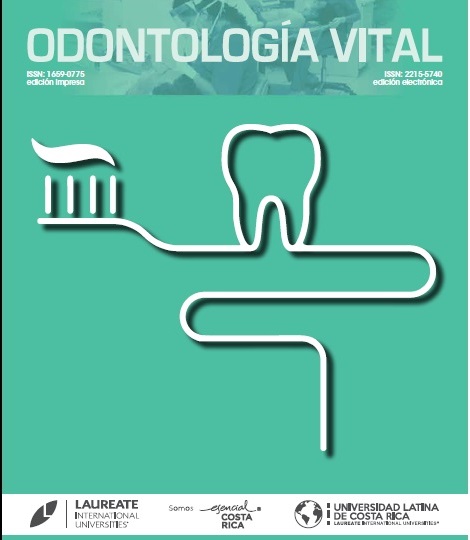Apical microfiltration between two filling cements: bioceramic and resinous in unirradicular premolars prepared with protaper and sealed with lateral condensation
DOI:
https://doi.org/10.59334/ROV.v2i31.329Keywords:
Microstraining, Endodontics, Thermal Gradient, Methylene BlueAbstract
Aim: To compare in vitro by the stereomiscroscope the lesser apical microfiltration in uniradicular premolars, between the cement based on Epoxy Resin and Bioceramic cement.
Method: The study was performed on 40 uniradicular dental pieces divided into two groups, the samples were prepared using the protaper system and the obturation was performed using the lateral condensation technique, the first group was sealed with Endosequence bioceramic cement and the second group with Cement based on AH-Plus epoxy resin, then sealed with nail varnish up to 3mm from the apical part, then the samples were placed in the incubator at 37ºC, waiting for the set time corresponding to each group according to the manufacturer’s instructions . The two groups of the present study were submitted to 750 cycles of thermocycling, to provide an environment similar to the oral cavity, then longitudinal cuts were made to the samples. The microfiltration was evaluated using the dye diffusion method, immersed in 2% methylene blue for 6 days, then the specimens were subjected to a vacuum pump. The teeth were cut longitudinally to be evaluated by the stereomicroscope. The statistical analysis was through T-Student and Chi-Square.
Results: Group A corresponds to Endosequence obtained a mean of 0,55mm and Group B corresponds to AH-Plus 1,20mm with an estimated significance of p = 0,013.
Conclusion: Both obturation cements have significant differences, therefore Endosequence has less apical microfiltration than AHPlus.
Downloads
References
Amlani, H. & Hegde V. (2013). Microleakage: Apical Seal vs Coronal Seal. World Journal of Dentistry 4(2). p. 113-116. https://doi.org/10.5005/jp-journals-10015-1215
AL-Haddad A. (2016). Bioceramic-Based Root Canal Sealers: A Review. International Journal of Biomaterials. p. 1-10. https://doi.org/10.1155/2016/9753210
Bergenholtz, G.H.B., Claes, R. (2007). Endodoncia diagnòstico y tratamiento de la pulpa dental. México: Manual Mo-derno.
Bergenholtz, GHB,&CR. (2011). Endodoncia diagnòstico y tratamiento de la pulpa dental. México: Manual Moderno.
Canalda, C., Brau, E. (2014). Endodoncia: Técnicas Clínicas y Bases Científicas. Barcelona, España: Masson.
Cohen S&. (2011). Vías de la Pulpa. 10th ed. Barcelona: Elsevier.
Cols, RGy. Estudio comparativo de filtración microbiana coronal con tres diferentes materiales de restauración provisional en dientes obturados con Guttaflow. Revista Odontológica Mexicana. 2010 Marzo; 14(1): p. 21-31.
Emre Nagas DPMOUDPAEDZCCDPPKVDPLVJLDPVDDP. Dentin Moisture Conditions Affect the Adhesion of Root Canal Sealers. JOE. 2012 Febrero; 38(2). https://doi.org/10.1016/j.joen.2011.09.027
García, E. (2015). Patología y terapéutica dental. Madrid: ELSEVIER;
Guerrero C. RH,VR,MJ,MJ,LJ,&LM. (2010). Evaluación del sellado apical de sistemas resinosos en la obturación de conductos radiculares: Estudio in vitro. Acta Odontológica Venezolana.
Huimin Zhou PYSDPWZPLLPYfZPMHDP. Physical Properties of 5 Root Canal Sealers. 2013 Octubre; 39. https://doi.org/10.1016/j.joen.2013.06.012
Ines Willershausen ACBByBW. In vitro analysis of the cytotoxicity and the antimicrobial effect of four endodontic sealer. PubMed. 2011 Agosto 10. https://doi.org/10.1186/1746-160X-7-15
Jaykumar, V. DL,PS,BR,GJ. Evaluation of push-out bond strength of endosequence BC sealer with lateral condensation and thermoplasticized technique: An in vitro study.
Jitaru, S. HI,TL,LAaBM. (2016). The use of bioceramics in endodontics- literatura review. Clujul Medical. https://doi.org/10.15386/cjmed-612
Journal of Conservative Dentistry. 2015 Marzo-Abril;: p. 124-127.
Nasseh, D. The rise of bioceramic. Endodontic Practice. 2009 Agosto.
Leonardo,M.R. (2005). Endodoncia: Tratamiento de Conductos Radiculares Sao Paulo, Brasil: Artes Médicas.
Lima Machado, M- (2009). ENDODONCIA: de la Biología a la Técnica. Sao Paulo: Amolca;
Lima Machado M. (2016). Endodoncia: Ciencia y Tecnología. Sao Paulo: AMOLCA
Pawwar SS PMMS. Evaluation of the apical sealing ability of bioceramic sealer, AH plus & epiphany: An in vitro study. Department of Conservative Dentistry and Endodontics. 2014 Oct 04; 17: p. 579-582. https://doi.org/10.4103/0972-0707.144609
Philip, L., Nick, A & Phillip Tomson. (2009). Endodoncia: Clínica práctica Madrid: Ripiano, S.A.
Rodríguez, I. JJ,PL. Estudio comparativo de filtración microbiana coronal con tres diferentes materiales de restauración provisional en dientes obturadores con Gutaflow. Revista Odontológica Mexicana. 2010 Marzo; 14: p. 21-31.
Romero G. RJ,&DA. (2012). Comparación in vitro de la microfiltración apical del MTA ProRoot y Angelus en dientes monorradiculares. Scielo Avances en Odontoestomatología. https://doi.org/10.4321/S0213-12852012000300003
Sáenz, C GJCE. Estudio comparativo de la microfiltración apical de tres sistemas de obturación endodóncica: Estudio in vitro. Revista Odontológica Mexicana. 2009 Septiembre; 13: p. 136-140.
Villena H. (2012). Endodoncia: Terapia Pulpar en Endodoncia. Madrid, España: Ripano,S.A.
Taccio, G. DMCF,DHA,MPCD,aGG,DMP. Evaluation of Radiopacity, pH, Release of Calcium Ions, and Flow of a Bioceramic Root Canal Sealer. JOE. 2012 junio; 38(6). https://doi.org/10.1016/j.joen.2012.02.029
Walton, RE. Endodoncia Principios y Práctica: Elsevier Saunders
Weine, F. Endodontic Therapy. Elsevier. 1996 diciembre 22.
Yánez, A. Cementos de Obturación Biocerámicos: Una nueva alternativa en Endodoncia. Canal Abierto. 2015 abril 31
Downloads
Published
Issue
Section
License
Copyright (c) 2019 Cristina Katerine Fajardo Loaiza, Isadora Martini García, Paola Andrea Mena Silva, Raquel Esmeralda Guillén Guillén

This work is licensed under a Creative Commons Attribution 4.0 International License.
Authors who publish with Odontología Vital agree to the following terms:
- Authors retain the copyright and grant Universidad Latina de Costa Rica the right of first publication, with the work simultaneously licensed under a Creative Commons Attribution 4.0 International license (CC BY 4.0) that allows others to share the work with an acknowledgement of the work's authorship and initial publication in this journal.
- Authors are able to enter into separate, additional contractual arrangements for the non-exclusive distribution of the Odontología Vital's published version of the work (e.g., post it to an institutional repository or publish it in a book), with an acknowledgement of its initial publication.
- Authors are permitted and encouraged to post their work online (e.g., in institutional repositories or on their website) prior to and during the submission process, as it can lead to productive exchanges, as well as earlier and greater citation of published work.







